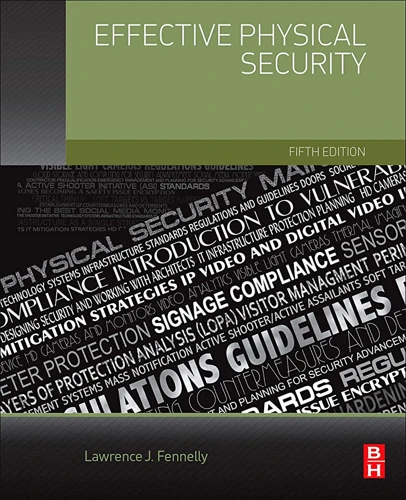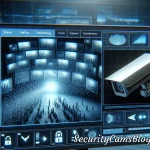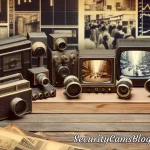With the rise in crime rates across the globe, many individuals and businesses are turning to video surveillance as a crime prevention tool. However, installing and using a video surveillance system requires more than simply mounting cameras and hitting record. Effective video surveillance policies and procedures are critical to maximizing the potential of your system. In this article, we will guide you through the best practices for planning, installation, maintenance, and policies and procedures to help ensure your video surveillance system is effective in preventing and solving crimes. So, whether you’re a business owner looking to protect your property or an individual concerned about the safety of your home, read on to discover how to make the most of your video surveillance system.
Part 1: Planning and Preparation

When it comes to video surveillance, preparation is the key to success. By planning carefully, you can maximize the effectiveness of your system and create a comprehensive approach to crime prevention. In this section, we’ll walk you through the essential steps of planning and preparation, including assessing your property needs, choosing the right equipment, creating a site map, and determining camera placement. By following these steps, you’ll be on your way to a secure and safe environment. To learn more about the benefits of video surveillance in crime prevention, check out our video surveillance and crime prevention article.
1.1 Assess Your Property Needs
Assessing your property needs is the first step in implementing an effective video surveillance policy. It involves a comprehensive analysis of your security objectives and the risks involved in your property.
The following are some key considerations for assessing your property needs:
- Identify the areas that need surveillance – Start by identifying the areas that need monitoring in your property. This could be entrances, exits, parking lots, interior spaces, or any high-risk areas where suspicious activity is likely to occur.
- Choose the type of surveillance – Choose the type of surveillance that best fits your security needs. Depending on the size of your property, you can opt for a wired or wireless system, or a combination of both.
- Determine the level of detail required – Consider the level of detail you need to capture in your video footage. Higher resolution cameras provide better image quality, allowing for clearer facial recognition and license plate reading.
- Assess lighting conditions – Evaluate the lighting conditions in your property to determine whether additional lighting is needed to enhance the image quality of your video footage.
- Consider the storage needs – Determine the amount of storage space you will need to store your video footage. This will depend on the number of cameras installed and the length of time you will need to retain the footage.
Assessing your property needs is critical in determining the type of surveillance system that will work best for you. By taking the time to evaluate your security objectives and risks, you can create a policy that meets your specific needs. Proper planning and preparation can help prevent crime and ensure the safety of your property.
If you want to learn more about how video surveillance can prevent crime, check out 5 Ways Video Surveillance Can Help Prevent Crime.
1.2 Choose the Right Equipment
Choosing the right equipment is crucial for the effectiveness of your video surveillance system. Here are some factors to consider when selecting surveillance equipment:
1. Camera Type
There are many different types of cameras available, including dome, bullet, and PTZ (pan-tilt-zoom) cameras. Consider which type of camera will work best for your specific needs. For example, dome cameras are great for indoor use, while bullet cameras are better for outdoor use due to their weather-resistant features.
2. Image Quality
The image quality of your cameras is important for proper identification and recording of events. It’s recommended to choose cameras that have a high resolution, as this will provide clearer images and better detail.
3. Storage Capacity
Your surveillance system should be able to store footage for a sufficient amount of time. Consider the amount of storage capacity you will need based on how long you want to keep the footage and how often you plan to review it.
4. Video Analytics
Some cameras come equipped with advanced video analytics that can detect and alert you to suspicious activity. This feature can be very helpful in preventing crime.
5. Integration with Other Systems
Your video surveillance system can be even more effective when integrated with other security systems, such as access control and intruder alarms. Make sure your cameras are compatible with these systems to optimize your overall security.
When choosing your equipment, be sure to research reviews and consult a professional installer to ensure you get the best equipment for your needs. Making the right choice can greatly enhance your system’s ability to prevent crime.
If you want to learn more about video surveillance and its role in crime prevention, check out our related article on video surveillance policies and procedures for businesses.
1.3 Create a Site Map
Creating a site map is an important step in the planning and preparation process of installing a video surveillance system. A site map is a diagram that shows the layout of your property and the placement of cameras. It is crucial because it helps to identify the areas that need to be monitored and where to position the cameras so that there are no blind spots.
Here are some steps to consider when creating a site map for your video surveillance system:
- Start by sketching a rough outline of your property, noting the location of entrances, exits, and any other points of interest or concern.
- Next, review the results of the security assessment conducted during the planning process. This will help to identify the areas that need to be monitored and the level of surveillance required.
- Once you’ve identified the areas that need to be monitored, use different colored markers or pins to mark the locations of the cameras on your site map. This will help you to visualize the coverage of your surveillance system and to ensure that there are no blind spots.
- Consider the lighting conditions of each area and determine whether or not additional lighting is required to improve camera performance. Include information about the lighting conditions on your site map, as this will help you choose the appropriate equipment and camera placement.
- The site map should also include the location of the monitor and recording equipment. Make sure to indicate where each camera is connected and the direction it is pointing in. This will help you to locate footage quickly during playback.
- Finally, label the areas on the site map in order to clearly identify them on the monitor as well as areas where access is limited. This will help you to easily locate footage and identify any suspicious activity.
By taking the time to create a detailed site map, you can ensure that your video surveillance system is comprehensive and effective in protecting your property from potential criminal activity. Now that you have created the site map, it’s time to move on to the next step in the planning process – determining camera placement. For more information about the benefits of video surveillance in residential crime prevention, you can follow this link.
1.4 Determine Camera Placement
When determining where to place your video surveillance cameras, it’s important to consider what areas of your property are most vulnerable to criminal activity. Here are some best practices for determining the optimal camera placement:
1. Identify High-Risk Areas: Start by assessing your property needs (as discussed in section 1.1). Identify areas that are most susceptible to criminal activity, such as entrances, exits, parking lots, and other areas where people gather.
2. Consider Lighting: Cameras need adequate lighting to capture clear footage. Assess the lighting in the areas you plan to monitor and ensure that there is enough illumination to capture clear footage.
3. Cover Blind Spots: Blind spots are areas where criminals can commit crimes without being seen by the cameras. Identify potential blind spots and consider how to cover them with additional cameras or adjust the angle of existing ones.
4. Mind Camera Angle: The angle of your cameras will impact the quality of the video footage. Consider mounting your cameras at a higher angle to capture a wider field of view. Additionally, it’s important to avoid pointing cameras directly into bright light sources, such as the sun or headlights, which can cause glare.
5. Follow Legal Requirements: Be sure to follow legal requirements and restrictions for surveillance cameras in your area. Some states require that you post signage to inform people that they are being recorded, while others prohibit camera placement in certain areas.
By following these best practices, you can ensure that your cameras are placed in the optimal locations to capture clear footage of criminal activity on your property. For more information on how video surveillance can be used for crime prevention, check out our video surveillance case studies for examples of successful implementation (insert link to /video-surveillance-case-studies-crime-prevention-success/).
Part 2: Installation and Maintenance

Now that you’ve planned your video surveillance system, it’s time to move on to the installation and maintenance process. Proper installation and regular maintenance are crucial for ensuring that your system functions optimally at all times. A poorly installed or maintained system could compromise your property’s security by failing to capture critical footage or producing low-quality video that is difficult to use in investigations. In this section, we’ll discuss the steps you need to take to ensure that your video surveillance system is installed correctly, maintained properly, and functioning as intended. If you want to learn more about the psychology of crime prevention and video surveillance, check out our previous article. Additionally, for tips on how to go beyond video security to protect your property, take a look at our related article.
2.1 Hire a Professional Installer
When it comes to installing a video surveillance system, it’s important to hire a professional installer to ensure that the job is done correctly. Here are some reasons why:
| Expertise in Equipment: | A professional installer has the expertise to select the right equipment that will meet your surveillance needs. They will help you choose the right cameras, recorders, and video management software. |
| Professional Installation: | Professional installers have the experience and expertise to install your video surveillance system efficiently and without errors. They know how to run cables without exposing them or interfering with other systems in your building. |
| Warranty and Guarantee: | Most professional installers offer a warranty and guarantee on their work. This means that if there are any issues with the installation or equipment, they will come back and resolve the issue at no extra cost to you. |
| Save Time and Money: | Hiring a professional installer can save you time and money in the long run. They can quickly and efficiently install your system, reducing the amount of downtime for your business. Additionally, a professional installation will minimize the need for future repairs and maintenance. |
| Compliance with Regulations: | Professional installers have knowledge of the laws and regulations that govern video surveillance systems. They will ensure that your system is installed in compliance with local, state, and federal regulations to avoid any legal issues down the road. |
Hiring a professional installer for your video surveillance system is an investment in the security and safety of your property. It ensures that the system is installed correctly, efficiently, and in compliance with regulations. It saves you time and money in the long run, and provides you with the peace of mind that comes with knowing that your surveillance system is in good hands.
2.2 Maintain Your Equipment Regularly
Regular maintenance is crucial for ensuring that video surveillance equipment is functioning properly and providing accurate and reliable footage. Here are some best practices for maintaining your equipment:
| Task | Frequency |
|---|---|
| Inspect cameras for physical damage | Weekly |
| Clean camera lenses | Monthly |
| Check and clean camera housing | Quarterly |
| Inspect and clean all cables | Semi-annually |
| Test and verify camera angles and positioning | Annually |
Inspect Cameras for Physical Damage
Inspect your cameras for any physical damage or wear and tear on a weekly basis. Check for damage to the casing, lenses or wiring. Damaged equipment can affect the quality of video footage and may need repair or replacement.
Clean Camera Lenses
Dirty or dusty camera lenses can impair the quality of the footage captured. It is recommended to clean lenses with a soft lens cleaning cloth or compressed air on a monthly basis.
Check and Clean Camera Housing
Camera housings should be checked regularly for any damage, deterioration or debris build-up. Dust, dirt or debris build-up can affect the camera’s image quality or recording capabilities. Camera housing should be cleaned on a quarterly basis.
Inspect and Clean all Cables
Regular inspection and cleaning of your cables can help ensure that there are no loose connections or damage to the cables. Loose connections can impede video signals, and damage to the cables can result in equipment failure. Cables should be inspected and cleaned semi-annually.
Test and Verify Camera Angles and Positioning
Over time, the position of your cameras may shift or become misaligned, which can adversely affect the quality of your footage. It is recommended to test and verify camera angles and positioning annually.
By following these maintenance tasks, you can ensure that your video surveillance equipment is performing optimally, and minimize the risk of any unexpected technical issues or equipment failure that may result in compromised security or loss of footage.
2.3 Backup Your Video Footage
Backing up your video footage is crucial in ensuring the effectiveness of your video surveillance system. It provides a failsafe in case of system failure or tampering, as well as helps with investigations.
Here are several steps to back up your video footage:
- Choose a reliable storage device: When selecting a storage device, consider the amount of footage you need to keep and the retention period. It’s important to use high-quality and reliable storage devices to avoid any loss of footage.
- Determine the backup schedule: Decide how often you want to backup your footage. This should depend on the amount of footage you generate and the size of your storage device. Typically, backups should occur at least once a week, if not more frequently.
- Automate backups: Enable automated backups on your system to streamline the process and ensure consistent backup times.
- Store backups off-site: In the event of a natural disaster or theft, it’s important to have backups stored off-site. This can be done through cloud backups or physical copies stored at a different location.
- Test your backups: Regularly test your backups to make sure they are functioning properly and can be restored if necessary. This helps prevent any potential issues when trying to retrieve footage for investigations or legal purposes.
Following these steps will ensure that you always have access to your video footage when it’s needed. Don’t take any chances with the security of your property – always back up your surveillance video footage.
Part 3: Policies and Procedures

In order to successfully implement video surveillance as a crime prevention measure, policies and procedures must be put in place to ensure that the system is used effectively and ethically. This section will provide guidance on creating a comprehensive video surveillance policy, training staff on proper usage, and developing response procedures. Failure to have clear policies can lead to legal and ethical complications, so it’s important to approach this step with care and attention to detail. Let’s dive in to explore best practices for establishing policies and procedures for your video surveillance system.
3.1 Develop a Video Surveillance Policy
Developing a video surveillance policy is a crucial component of any effective security strategy. This policy should outline the acceptable uses of video surveillance and ensure that the privacy of individuals on the property is respected.
To create an effective policy, it’s important to involve all relevant stakeholders in the process, including employees, legal advisors, and local law enforcement. The policy should be well-defined, clear, and easily accessible to all employees and visitors.
Here are some key elements that should be included in a video surveillance policy:
| Element | Description |
|---|---|
| Goals | The policy should clearly state the goals of the video surveillance system, such as deterring criminal behavior, improving incident response, and protecting property and employees. |
| Authorized Personnel | The policy should designate who is authorized to access the video surveillance footage and under what circumstances. It should also include guidelines for how this footage should be used and stored. |
| Camera Locations | The policy should outline where cameras are placed and why they are located in those areas. It should also state whether or not there are any areas on the property that are off-limits for video surveillance. |
| Retention Period | The policy should specify how long video footage will be retained and how it will be stored. It should outline who is responsible for maintaining this footage and who has access to it. |
| Notification | The policy should outline how individuals will be notified of the presence of video surveillance and how they can access the policy for more information. It should also state how complaints regarding the surveillance system should be handled. |
| Legal Considerations | The policy should address any legal considerations, such as local privacy laws, and ensure that the surveillance system is implemented in accordance with these laws. |
A comprehensive video surveillance policy can help protect your property, employees, and customers, but it must be accompanied by proper training and procedures. It’s important to regularly review and update the policy to ensure that it remains relevant and effective.
3.2 Train Your Staff
Training your staff is a critical step in ensuring your video surveillance system is used effectively. Without proper training, your employees may not know how to operate the system correctly, which can lead to ineffective surveillance.
Here are some best practices for training your staff:
| Step | Description |
|---|---|
| Step 1: | Start with a general overview of why the surveillance system is in place and the goals of the program. This will help employees understand how the system fits into the organization’s overall security strategy. |
| Step 2: | Provide detailed instructions on how the system works, including how to access live and recorded video, how to control cameras, and how to save and export footage. |
| Step 3: | Highlight important policies and procedures related to the system, including guidelines for reviewing footage, who has access to the system, and the consequences of misuse. |
| Step 4: | Demonstrate examples of suspicious activity that employees should be on the lookout for, and show them how to report any incidents they observe. |
| Step 5: | Provide regular refresher training to ensure employees are up-to-date with any changes in policies or procedures, and to reinforce the importance of using the system correctly. |
Remember, properly trained employees are a key factor in the success of your video surveillance program. By investing in their education, you’ll be helping to create a safer and more secure environment for everyone.
3.3 Create Response Procedures
Creating response procedures is an essential aspect of effective video surveillance policies. It’s important to have a plan in place for how to handle suspicious activity or incidents caught on the cameras. Here are some steps you can take to create response procedures:
- Identify potential incidents: Review footage from previous incidents to determine the types of activities that may require a response. Consider activities such as theft, vandalism, or trespassing.
- Determine who will respond: Assign responsibility for monitoring the cameras and responding to incidents. This person or team should be trained in the response procedures and able to act quickly and appropriately.
- Define the response: Develop a clear plan for how to respond to specific incidents. This may include contacting the police, sounding an alarm, or contacting the property owner or manager.
- Establish communication channels: Ensure that those responsible for monitoring the cameras and responding to incidents have a reliable means of communication. This may include two-way radios, cell phones, or other devices.
- Test the procedures: Regularly test the response procedures to ensure they are effective and make any necessary adjustments. This may involve conducting drills, simulations, or other training exercises.
By following these steps and creating response procedures that are specific to your property and equipment, you can improve security and mitigate risk.
Part 4: Making the Most of Your System
Now that your video surveillance system is installed and in good working order, it’s important to make the most of it. Your investment in this technology is valuable, and with a little attention and effort, you can reap the rewards of a safe and secure property. In this section, we’ll explore how you can maximize the benefits of your surveillance system with a few best practices. From regular monitoring to quick response times, there are plenty of ways to leverage your system to its fullest potential. Let’s dive in!
4.1 Monitor Your System Regularly
Regular monitoring of your video surveillance system is a critical component of ensuring the safety and security of your property. Here are some best practices to follow:
- Set a schedule: Determine a schedule for monitoring your surveillance cameras. This could be during business hours, after hours, or both. A set schedule ensures that your system is being monitored consistently.
- Assign responsibilities: Assign specific staff members to be responsible for monitoring the surveillance cameras. Make sure they are trained on how to effectively monitor the footage and know how to respond to any suspicious activity.
- Check for malfunctions: Regularly check for any malfunctions or technical issues that may cause your cameras to stop working properly. This can include power outages, weather damage, or outdated equipment. Fix any issues as soon as possible to maintain the integrity of your surveillance system.
- Review footage: Reviewing footage regularly can help you identify any patterns of suspicious activity or potential security vulnerabilities in your property. It can also aid in investigations should an incident occur.
Remember, monitoring your system regularly is not only important for crime prevention, but it can also help you make informed decisions about the safety and security of your property. By implementing a regular monitoring schedule and following these best practices, you can have peace of mind knowing that your property is being monitored and protected around the clock.
4.2 Respond Quickly to Suspicious Activity
When suspicious activity is detected on your surveillance system, it’s crucial that you respond quickly and appropriately. Delayed responses can result in serious consequences and jeopardize the safety of your premises. Here are some best practices for responding to suspicious activity:
- Train your staff to recognize and report suspicious behavior. Provide them with a clear definition of what constitutes suspicious behavior, such as loitering, unauthorized access, or vandalism. Encourage them to report any suspicious activity immediately to your security team or the police.
- Establish a protocol for responding to alarms or alerts. Ensure that all alarms and alerts are being monitored and that there is a clear plan in place for responding to them. Provide your staff with a clear list of instructions for responding to different types of alarms, and make sure that they know who to contact in the event of an emergency.
- Follow up on any suspicious activity. Investigate any suspicious activity detected by your surveillance system, and keep a detailed record of your findings. This information can be useful in identifying patterns or trends, and can help you make better decisions about allocating your resources.
- Communicate with law enforcement. If you detect suspicious activity that warrants police intervention, don’t hesitate to contact them. Provide them with as much information as possible about the suspicious behavior you’ve observed, including timeframes and camera footage if available. This can help them respond more effectively and increase the likelihood of a positive outcome.
- Re-evaluate your system. If you find that your system is frequently detecting suspicious activity, you may need to re-evaluate your setup to identify weak points. Consider adding additional cameras or changing their placement to get better coverage of vulnerable areas. Regularly assess your system’s effectiveness to ensure that it’s meeting your needs as conditions change over time.
Responding quickly and appropriately to suspicious activity is crucial for effective surveillance. Keep your staff trained, establish clear protocols for responding to alarms and alerts, follow up on suspicious activity, communicate with law enforcement when necessary, and consider evaluating and upgrading your system if needed.
4.3 Use Your Footage to Aid Investigations
After an incident, the footage captured by your video surveillance system can aid investigations, help identify suspects, and provide valuable evidence in court. To make the most of your system, it’s important to establish procedures for accessing and reviewing footage.
Here are some best practices for using your footage to aid investigations:
- Keep a backup of all footage: Ensure that all footage is backed up and stored securely to prevent loss or tampering.
- Train staff on how to access footage: Make sure that authorized personnel are trained on how to properly access and download footage.
- Review footage promptly: When an incident occurs, review the footage as quickly as possible while the details are still fresh in everyone’s mind.
- Label footage accurately: Label all footage clearly with the date, time, and location to make it easier to locate relevant footage later.
- Share footage with law enforcement: If an incident requires police involvement, be prepared to provide them with any relevant footage in a timely manner.
- Use footage to improve security: Regularly review footage to identify any patterns or areas of weakness in your security measures and use this information to make improvements where necessary.
By following these best practices, you can use your video surveillance system to not only prevent crime, but also to help solve it when it does occur.
Conclusion
In conclusion, implementing a video surveillance policy can be an effective tool for preventing crime and ensuring the safety and security of your property. However, it is important to approach the planning, installation, and maintenance of your system with careful consideration and attention to detail.
By assessing your property needs, choosing the right equipment, creating a site map, determining camera placement, hiring a professional installer, and maintaining your equipment regularly, you can ensure that your system is optimized to meet your specific security needs.
Developing a video surveillance policy, training your staff, and creating response procedures can also help to maximize the effectiveness of your system and ensure that your team is well-equipped to respond to any security threats.
Finally, monitoring your system regularly, responding quickly to suspicious activity, and using your footage to aid investigations can all help you make the most of your video surveillance system and maintain the safety and security of your property.
Remember, a video surveillance system is only as effective as the planning, preparation, and policies and procedures behind it. By taking the time to implement best practices for crime prevention, you can ensure that your system is optimized to meet your needs and keep your property safe from harm.
Frequently Asked Questions
1. How can video surveillance help prevent crime?
Video surveillance can help prevent crime by acting as a deterrent for potential criminals. Knowing that their actions are being recorded can discourage individuals from committing crimes in the first place.
2. What are the legal considerations when implementing video surveillance?
Legal considerations when implementing video surveillance include obtaining consent from individuals being recorded, following privacy laws, and ensuring video footage is used appropriately and securely.
3. Can video surveillance be used for employee monitoring?
Video surveillance can be used for employee monitoring, but it must adhere to legal and ethical guidelines. Employers must inform employees that they are being recorded and ensure footage is not used for discriminatory purposes.
4. What is the cost of implementing a video surveillance system?
The cost of implementing a video surveillance system varies depending on the size and complexity of the property being monitored. It can range from a few hundred dollars for a basic DIY system to thousands of dollars for a comprehensive professional installation.
5. Is it necessary to hire a professional installer for a video surveillance system?
While it is possible to install a video surveillance system yourself, hiring a professional installer can ensure the system is installed correctly and minimize the risk of technical problems or security breaches.
6. How often should video surveillance equipment be maintained?
Video surveillance equipment should be maintained regularly to ensure optimal performance. This can range from monthly check-ups to yearly servicing, depending on the size and complexity of the system.
7. How long should video footage be stored for?
The length of time video footage should be stored for depends on various factors, including legal requirements, industry regulations, and the nature of the property being monitored. It is important to review storage requirements and adjust settings accordingly.
8. What should be included in a video surveillance policy?
A video surveillance policy should include guidelines for capturing, storing, and using video footage, as well as procedures for accessing footage, handling complaints, and addressing privacy concerns. It should also detail employee expectations and training requirements.
9. How can video surveillance help aid investigations?
Video footage can provide valuable evidence in criminal investigations, such as identifying suspects or tracking their movements. It can also help businesses identify potential liabilities, such as slip-and-fall accidents.
10. What is the best way to monitor a video surveillance system?
The best way to monitor a video surveillance system is to establish regular monitoring schedules and procedures, including checks for technical problems and suspicious activity. Additionally, businesses should train staff on best monitoring practices and response procedures.







